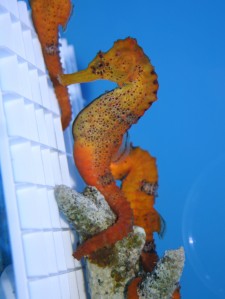There are two species of Ricordea readily found in the aquarium hobby; the Yuma and the Florida. Both offer an  amazing pallet of colors and vary in size. The Yuma variety is found in the Indo-Pacific region, while the Florida species is found in the Caribbean and around coastal Florida. Ricordea yuma are typically the larger variety, but tend to be more difficult to keep alive. They are also more expensive, with some prices topping $100 per polyp. The Florida species are by far hardier and can tolerate a wider range of lighting. Florida ricordea can be expensive, but typically not much more than $50 per polyp, more on the average of $20 to $30 dollars per polyp.
amazing pallet of colors and vary in size. The Yuma variety is found in the Indo-Pacific region, while the Florida species is found in the Caribbean and around coastal Florida. Ricordea yuma are typically the larger variety, but tend to be more difficult to keep alive. They are also more expensive, with some prices topping $100 per polyp. The Florida species are by far hardier and can tolerate a wider range of lighting. Florida ricordea can be expensive, but typically not much more than $50 per polyp, more on the average of $20 to $30 dollars per polyp.
As far as water quality, a healthy reef system is all they require with an average of 3-5 watts per gallon of lighting. They can thrive under Power Compact, Metal Halide, and T-5 lighting. If the ricordea becomes well established and “happy” in your aquarium, they will begin to divide, leaving you with more ricordea than you originally purchased. You can also force them to divide by cutting them in half or if you are feeling lucky, in quarters. Water flow can be variable, low to moderate and more turbid. Try to avoid high, laminar flow, it can cause the ricordea to detach or just to melt away in the worst case. They make a great addition to smaller aquariums because they typically only get a few inches in diameter while having very little aggression towards other corals. Like many other corals, they will “fight” back if too close to other corals, so give them a little room to grow. Through photosynthesis, ricordea gain a majority of their food. However, they will also feed on phytoplankton and zooplankton.
 The Florida ricordea found in the aquarium trade are collected throughout the Caribbean and Florida. However, new regulations in Florida that are set to begin in July may cause the price to increase. The limits on collection are going to decrease by more than 50 percent. This should force the price of each polyp to increase noticeably. The drastic increase should be offset slightly by the import of ricordea from places like Haiti.
The Florida ricordea found in the aquarium trade are collected throughout the Caribbean and Florida. However, new regulations in Florida that are set to begin in July may cause the price to increase. The limits on collection are going to decrease by more than 50 percent. This should force the price of each polyp to increase noticeably. The drastic increase should be offset slightly by the import of ricordea from places like Haiti.
Overall, I would highly recommend the Florida Ricordea to anyone with a healthy reef tank. The color variety and hardiness make this coral a perfect choice for most aquariums, small and large.
 That Fish Blog – Aquarium Advice and Information
That Fish Blog – Aquarium Advice and Information






 snout that enables them to suck in prey items like brine shrimp, copepods, and other similar crustaceans. Seahorses and their relatives are timid and slow-moving. They are most often found in beds or sea grass where they can use their tails to anchor themselves to the grass or corals and not be carried off by the current. Seahorses bear live young that are carried in a pouch, similar to a Kangaroo, until they are mature enough to be released.
snout that enables them to suck in prey items like brine shrimp, copepods, and other similar crustaceans. Seahorses and their relatives are timid and slow-moving. They are most often found in beds or sea grass where they can use their tails to anchor themselves to the grass or corals and not be carried off by the current. Seahorses bear live young that are carried in a pouch, similar to a Kangaroo, until they are mature enough to be released.